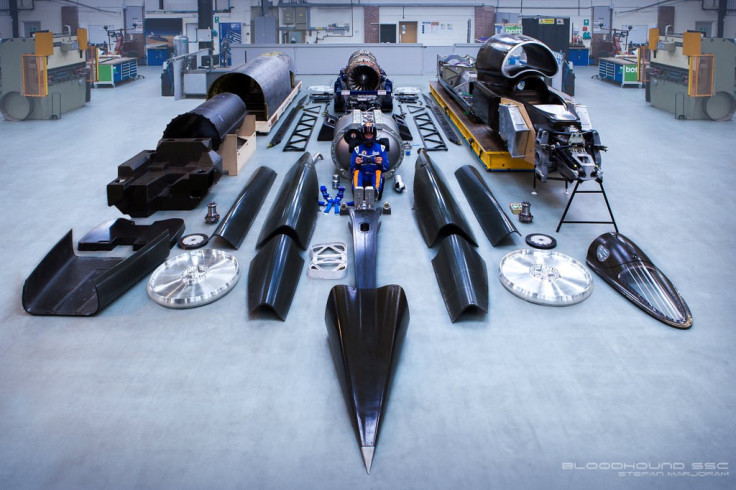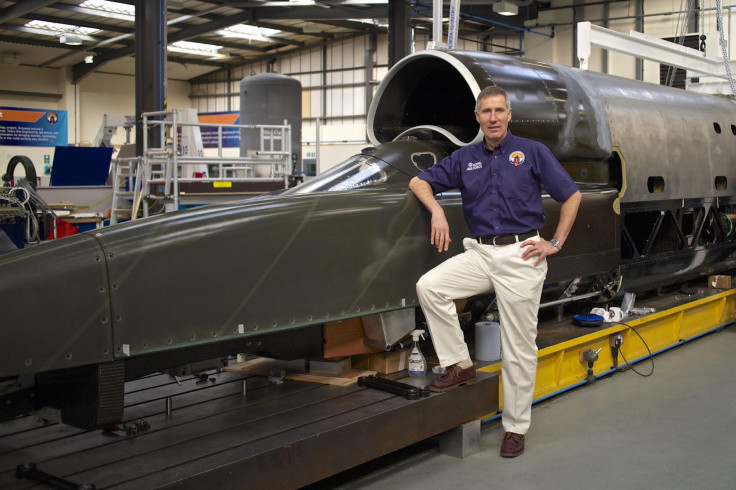Bloodhound SSC: 1,000mph car built to inspire the next generation of British engineers
It is claimed that Britain's aircraft industry will lose 60% of its skilled workforce by 2020 due to an ageing population retiring with no successors. To fix this and encourage children to take up careers in science and engineering, two men met in a pub to discuss making a car capable of going 1,000mph.
Those two men were Richard Noble, an entrepreneur and former land speed record holder, and Andy Green, an RAF fighter pilot and current holder of the land speed record. Having decided years earlier that Green's 763mph record, set driving Thrust SSC in 1997, could not be beaten, the duo heard of an American attempt to go faster. To counter this and keep the record in British hands, Green and Noble embarked on the engineering project of the century - and one which would be driven by the desire to educate and inspire a new generation of engineers.
For Britain and for the hell of it
It would be easy to view Wing Commander Green and Bloodhound SSC (supersonic car) through the same rose-tinted glasses which made the nation proud of Malcolm and Donald Campbell and their Bluebird land speed record cars of the 1930s and 1960s. When asked why he chased the land and water speed records Donald said simply: "It's a goal worthwhile achieving". Having set a record of 633mph in 1983, Noble said he did it "for Britain and for the hell of it."

But times change, and from the beginning Noble and Green knew their dreams of 1,000mph (Mach 1.4) would only be realised if Bloodhound was used to educate; this is how they got their hands on three EJ200 jet engines, as used by the Eurofighter Typhoon fighter jet, and it is why Bloodhound's education programme is studied in thousands of schools the world over by children of all ages.
The project is open source, meaning everyone can read up on every piece of Bloodhound's design and construction - and when it starts running in mid-2015, all 60-plus runs will be recorded by high definition cameras and 400 sensors; all of this data will be streamed live to the internet and to classrooms around the world.
Closer to Concorde than Crossrail, Bloodhound is about capturing children's imagination, not just setting records for the hell of it.
The Apollo moment for the 21st century
From the Bloodhound Technical Centre - in reality little more than a large workshop on an industrial estate in Bristol - Green describes Bloodhound to IBTimes UK as "the world's most sophisticated race car, which is part Formula One racer, part supersonic jet fighter, part next-generation space rocket." This may sound like hyperbole, but Green isn't one to mince his words. A tall, straight-talking fighter jet pilot, he speaks in a clipped, clear accent produced by an Oxford education (mathematics, first class) followed by three decades in the RAF.
"We're going to hit the same audience as the Apollo. This is going to be the Apollo moment for the 21st century."
Built to race across a 12-mile stretch of the Hakskeen Pan in South Africa, Bloodhound is a 7.5-tonne, four-wheel vehicle with a bullet-proof carbon fibre cockpit, three engines and a Rolex speedometer which reads to 1,100mph. The car is initially powered by an EJ200, the same jet engine used by the Eurofighter Typhoon, then at around 350 mph Green hits a button on his 3D-printed magnesium steering wheel to light what is essentially a space rocket.

With a 550 horsepower Jaguar V8 acting as its fuel pump, the rocket's contribution takes Bloodhound's total power output to 135,000bhp - more than 150 Formula One cars. At top speed, Bloodhound will complete a measured mile in 3.6 seconds.
Driving in a straight line may seem less difficult than navigating a narrow, twisting race track, but Green will be working hard to keep Bloodhound in a straight line, as rising speeds cause the car's aerodynamic behaviour to change from one extreme to the other in a matter of seconds.
At 400mph I'm starting to fight the steering...it's like driving on ice
Green explains: "[Under 350mph] the steering will be dead and unresponsive, like a normal road car. When I fire the rocket the wheels start to plane on the surface and I'm starting to fight the steering. The wheels are now skimming across the surface and it's like driving on ice. The car is now wriggling; tiny gusts of crosswind will require big steering inputs to keep the car straight."
As Green passes through 700mph, shock waves start to form around the canopy as Bloodhound goes supersonic. A sonic boom will echo for 40 miles across the desert, the car now outrunning its own noise; but instead of serene quiet, the violence of Bloodhound's leading edges tearing the air apart is even louder than its rocket and jet engine.

Heading towards 1,000mph, the steering begins to settle as mounting air resistance presses the car into the ground. Relative calm will give Green a moment to check the three computer screens ahead of him to make sure temperatures, pressures and the loads on each wheel are within the narrow tolerances allowed without aborting the record attempt.
But seconds later the car's handling changes again. "As we go supersonic the handling changes dramatically. At Mach 1.2, 1.3, approaching 1,000mph [Mach 1.4], tiny changes in steering at the front wheels produce shock waves and huge side loads. Now a tiny change in the steering will generate a huge load and a huge response [and change of direction]. So I've gone from steering on ice to tiny, tiny steering inputs all in the space of 15 seconds as the car is accelerating."
A fairly violent experience
Exiting the 3.6-second measured mile - and with just five miles left until he reaches the turnaround team - Green initiates the violent, disorientating and blood-draining braking phase. By merely lifting his foot from the accelerator and switching off the rocket, 17 tonnes of drag slams Green into his harness with the force of 3G as Bloodhound slows by 60mph per second. "1,000, 940, 880... that's the equivalent of driving at 60mph and coming to a complete stop in one second. It's a fairly violent experience, and even worse when you've just been accelerating... physically and mentally it's very hard on the body."

Called the somatogravic illusion, a sudden switch from strong acceleration to deceleration causes the brain to think it is nose-diving into the ground. Using the RAF-taught anti-G straining manoeuvre, Green will tense his legs and stomach muscles to stop blood draining from his head, causing a 'greyout' and temporary blindness. Air brakes will be deployed, followed by parachutes, to drag the car down to 550mph, where "it all starts to calm down and get relatively peaceful, but I'll still be fighting with the steering to keep the car straight, fighting against crosswinds."
Finally, a pedal and conventional disc brakes slow the car to a stop, before the turnaround team gets to work. They load a tonne of hydrogen peroxide for the rocket, half a tonne of jet fuel and 100 litres of cooling water, then inspect all 20,000 rivets and download data collected by 400 sensors, before sending Green out on his return run. Both runs must cover the same measured mile and be completed within an hour for any record to stand.
Nervous, but not about crashing - viewers will mark my homework in real time
A purpose-built 4G network will capture data, HD video and Green's commentary as the car is being driven on every run it makes between now and the attempts on breaking 1,000mph in 2016. The data will be mixed, then sent 150 miles to the nearest town, Uppington, and uploaded to the web, where millions of people around the world "will be able to mark my homework in real time," Green says, adding this aspect is the closest he's likely to get to feeling fear or nerves while piloting Bloodhound.

Hundreds of thousands of schoolchildren in the UK and South Africa will get unrestricted access to all of the data produced by Bloodhound.
What's more exciting than breaking your own record? Breaking someone else's
The US attempt which prompted Noble and Green to crack 1,000mph, called the North American Eagle, has already run up to 400mph, while an Australian bid to break Green's record is also in development. But rather than being nervous of his rivals, Green told us he is disappointed in them.
"I'm very disappointed that they haven't managed to run their cars to records yet, because the one thing that's more exciting than breaking your own record is breaking somebody else's. My message to both of them is; please do break our record, because it will make our education programme so much richer...and second of all, guys, get a move on...you haven't got long until the world's fastest car is coming to get you.
"It's another golden age of the land speed record and it's a fabulous time to show off the very best of science and technology. I can't wait to get started."
Bloodhound will run at up to 200mph on a runway in the UK this summer, before heading to South Africa in September to reach 800mph. The team will then return in 2016 to crack 1,000mph.
Once that happens - and there is no reason to believe it will not - what will the world's fastest man do next?
"Sailing. Nothing over five knots is perfect for me."
© Copyright IBTimes 2025. All rights reserved.






















